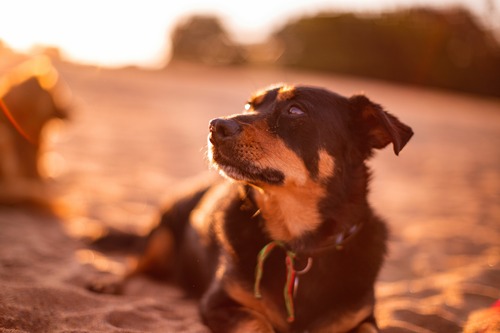Taking your dog to the beach can be a fun and exciting adventure, but sometimes our curious companions get into things they shouldn’t. If your dog ate sand, you may be feeling concerned about their well-being. Understanding the potential risks and knowing the appropriate steps to take can help you ensure your pet stays safe and healthy. In this article, we will explore what to do if your dog ate sand and when to seek veterinary care.
Why Do Dogs Eat Sand?
Dogs eat sand for various reasons. Some dogs are naturally curious and may ingest sand accidentally while playing or digging. Others might be attracted to the texture or the taste if it’s mixed with food or treats. However, eating sand can pose serious health risks to your dog, including digestive issues and intestinal blockages.
Potential Health Risks of Sand Ingestion
When a dog ingests sand, it can cause several health problems. Here are some potential risks associated with sand ingestion:
- Gastrointestinal Distress: Sand can irritate your dog’s digestive tract, leading to symptoms such as vomiting, diarrhea, and abdominal pain. These symptoms can cause discomfort and dehydration if not addressed promptly.
- Intestinal Blockages: One of the most serious risks of sand ingestion is the potential for an intestinal blockage. Sand can accumulate in your dog’s intestines, creating a blockage that prevents food and liquids from passing through. This condition is life-threatening and requires immediate veterinary attention.
- Dehydration: Consuming sand can lead to dehydration, especially if your dog is experiencing vomiting and diarrhea. Dehydration can worsen your dog’s condition and must be managed carefully.
- Electrolyte Imbalance: Severe vomiting and diarrhea can result in an electrolyte imbalance, which can affect your dog’s overall health and lead to complications such as muscle tremors or heart issues.
Signs Your Dog Ate Sand
Recognizing the signs that your dog has ingested sand is crucial for early intervention. Here are some symptoms to look out for:
- Vomiting
- Diarrhea
- Abdominal pain (whining, restlessness, or touch sensitivity)
- Lethargy
- Decreased appetite
Immediate Steps to Take if Your Dog Ate Sand
If you suspect that your dog has eaten sand, taking immediate action can help mitigate potential health risks. Here’s what you should do:
- Monitor your dog closely for any signs of distress or discomfort. Take note of any symptoms such as vomiting, diarrhea, or abdominal pain.
- Encourage your dog to drink plenty of fresh water. Hydration is essential, especially if your dog is experiencing vomiting or diarrhea.
- Do not attempt to induce vomiting unless instructed by a veterinarian. Inducing vomiting can sometimes cause more harm than good.
- Avoid feeding your dog a large meal. Instead, offer small amounts of bland food like boiled chicken and rice to see if they can keep it down without further vomiting.
- Reach out to your veterinarian for advice. Explain the situation and provide details about your dog’s symptoms. Your veterinarian can guide you on the next steps and whether an immediate visit is necessary.
When to Seek Veterinary Care
Knowing when to seek veterinary care is essential for your dog’s health. If your dog has persistent vomiting or diarrhea, signs of abdominal pain such as whining, panting or tense abdomen, lethargy or weakness, experiences dehydration, or these signs do not improve it’s time to contact your veterinarian or visit an emergency clinic as soon as possible.
What to Expect at the Vet
When you take your dog to the vet after they’ve eaten sand, the veterinarian will perform a thorough examination to assess their condition. Here’s what you can expect during the visit:
Physical Examination
The vet will check your dog’s vital signs, including temperature, heart rate, and hydration levels. They will also palpate your dog’s abdomen to check for pain or swelling.
Diagnostic Tests
Your vet may recommend diagnostic tests such as X-rays or an ultrasound to determine if there is an intestinal blockage or other complications. Blood tests may also be conducted to check for dehydration and electrolyte imbalances.
Treatment Plan
Based on the examination and test results, the vet will develop a treatment plan. This may include administering fluids to combat dehydration, medications to soothe the digestive tract, or surgery in severe cases of intestinal blockage.
Preventing Sand Ingestion in Dogs
Prevention is key to ensuring your dog doesn’t ingest sand in the future. Here are some tips to help you keep your dog safe:
- Keep a close eye on your dog while at the beach or in sandy areas. Supervision can help you intervene before your dog ingests sand.
- Bring along toys and interactive games to keep your dog engaged and distracted from eating sand.
- If your dog loves to dig, redirect their attention to other activities to minimize the risk of sand ingestion.
- After playing in the sand, clean your dog’s face and mouth to remove any residual sand.
- Ensure that your dog’s food and water bowls are free from sand, and avoid feeding them on the beach.
Taking Care of Your Dog’s Health
If your dog ate sand, knowing what steps to take can make a significant difference in their recovery. Always monitor your dog closely and consult with your veterinarian if you notice any concerning symptoms. By staying vigilant and taking preventive measures, you can help ensure your dog enjoys safe and fun outings without any health risks. For any concerns or to schedule an appointment, call McGehee Clinic for Animals at (901) 682-5684 or request an appointment online.





